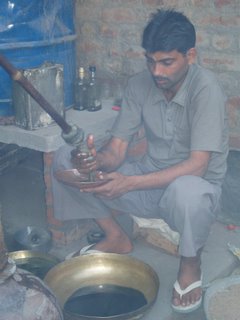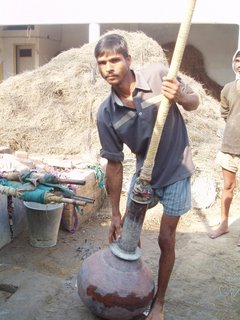Kannauj: Perfume capital of India
“If you want to visit a pefumery town, visit Kannauj. It is art, it is culture and it is heritage”- This is exactly how I felt when I visited Kannauj at the end of January.
 Traditional distillation units in Kannauj.
Traditional distillation units in Kannauj.
Kannauj is to India what Grasse is to France: the country’s perfume capital!!! Grasse has been the center of the perfumery industry in France ever since the 17th century and is now considered the birthplace of modern perfumery, where natural extracts are blended with a myriad of synthetic odoriferous chemical compounds. But in Grasse, the traditional techniques for extracting floral oils, such as enfleurage have been abandoned. Since the beginning of the 20th century, the perfumery industry in Grasse has never ceased to be modernized as fine perfumery was getting more and more popular throughout the World. I visited Grasse two years ago, like thousands of tourists do each year, on a day trip from the beach on the Côte d’Azur, eager to embark on a voyage through odors and maybe to a place where the daily routine of the people would be in unison with the flower picking and the various practices used to harvest the odorant substance from these flowers... But it seemed that the only remnants of this traditional livelihood (an old distillation apparatus and some chassis for the enfleurage technique) had been relegated to a display in the Musée International de la Parfumerie.
And so, when I arrived in Kannauj, famous for its sandalwood-based attar-making industry, it felt like I had undertaken a trip back in time- I had finally found what I had been looking for when going to Grasse!!! There, the attars are still made exactly like they were a few centuries ago, with the same equipment!
 A worker is squeezing vetiver oil (Khus Ruh) out of a mop.
A worker is squeezing vetiver oil (Khus Ruh) out of a mop.
At every street corner, it seemed, there was a sandalwood oil distillery, and so as I was walking through the city, my sense of smelling was awakened by the sweet and woody odor of sandalwood. Every morning, I was amazed to see a group of few men bathing in the water, still charged with fragrant molecules, that the distillery disposed of in the streets. Indeed, in Kannauj it is well known that sandalwood oil is an excellent antiseptic, and so bathing in this water ensures to keep away from skin diseases!!!
Kannauj, located near the confluence of the Ganges and Kali river is thought to be right on the routes that brought perfumes, spices, metals, silks and gems from India and China to the Middle East. It reached the climax of its glory during the 7th century AD when it was the capital of the empire led by Harsha Vardhan. It is during this period that Kannauj started to play an important role in Indian perfumery. Later, the perfumers of Kannauj provided the Mogul emperors with scented oils.
Perfumers in Kannauj are famous for making sandalwood-based attars. An attar is the essence of a flower (of a root, or even earth) that is captured in 100% sandalwood oil. Sandalwood oil is used as a base material because it has a strong fixative property and can keep the floral essence over a long period of time. Attar making is a type of hydrodistillation, where the plant material is placed in water in a copper still (Deeg). The still is covered by a copper lid (Sarpos) which is sealed to the Deeg with a mixture of cotton and clay. A bamboo pipe (Chonga) insulated with twine connects the still to a receiver which is placed in a cold water bath.
 A few Deegs with the bamboo pipe leading to the receiver placed in a cold water bath.
A few Deegs with the bamboo pipe leading to the receiver placed in a cold water bath.

In one of the factories, a worker is preparing for the next distillation, putting the bamboo pipe in the receiver
The plant material is placed in water in the Deeg. The still sits on a fire and upon heating, the odoriferous molecules from the plant material vaporize along with the water. The fragrant oil and the water condense in the receiver where the oil is trapped in the sandalwood oil as the condensed water sinks to the bottom of the receiver as it is denser than the sandalwood and the floral oil.
 Under the Deeg, firewood is used to heat the water and the plant material.
Under the Deeg, firewood is used to heat the water and the plant material.
Once the distillation is over, the odoriferous oil trapped in the sandalwood oil is placed in the sun in a leather bottle. The bottles used to be made out of camel skin, now they are made out of buffalo skin. And so the water is being evaporated through the buffalo skin.
 One of the leather bottles where residual water is dried from the final product.
One of the leather bottles where residual water is dried from the final product.I visited many attar and sandalwood oil factories. The smell of these attars is very strong and can be associated to a heavy oriental perfume. But it is subtle at the same time, as behind the rose or the jasmine odor, one can sense the sweet and woody note from the sandalwood. A very special attar is Attar Mitti. Instead of distilling plant material such as vetiver roots, rose or jasmine flowers, half-baked clay is being distilled. The clay is first collected in neighboring villages, where little clay cakes are made, they are then dried then baked and placed in the Deeg. The odor is a very sweet mixture where the woody and oriental note of the sandalwood is complemented by an earthly smell. Many inhabitants of Kannauj like this smell because it reminds them of the smell of wet earth after the monsoon.
 Cakes of clay are dried in a neighboring village.
Cakes of clay are dried in a neighboring village.
Some References:
Dr. Agnihotri, G.K. Perfume history.
Gode, P.K. (1961) Studies in Indian Cultural History, Vol. I, Hoshiarpur.
Kapoor, J. N. (1991) Attars of India- A Unique Aroma Perfumer and Flavorist, 21-24
3 Comments:
Hi, It was a good read. Wonder what you have done there? Were you here for research or some course? I am a perfumer here in India.
regards,
Mridual Kalia Bhatnagar
Laure-Anne, I am delighted to have found your blog when researching a perfume I am designing. I will pass this URL along to many perfumers and perfumistas and I will follow your travels with great interest and enthusiasm.
Hello : ) Very evocative read. i am currently writing a novel about a young man (Kesh) who becomes a renowned perfume maker. He is Indian from Mumbaî but from 16 onwards is London based and travels the world for scents, notes, fragrances... A lot of my story takes me to India and Sri Lanka, and having never been to either, I spend a lot of time on internet researching... Your story about Kannauj is wonderful stuff, a whole new and evocative discovery for me, thank-you : )
Lucy
Post a Comment
<< Home